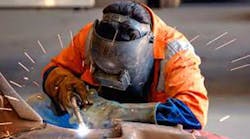CNBC.com posted an interesting article yesterday about the welding sector's push to court women to join its ranks.
This sounds like an uphill battle to me, especially after having read some of the readers' rants at the end of the article. My, how the sparks do fly.
Anyway, uphill or not -- and this should go without saying -- it's a battle worth fighting.
A few observations:
• "Available work is outpacing qualified tradespeople -- largely due to an aging workforce." There's no getting around this demographic über-fact that we often hear and read about. (In fact, here's a recent article on the baby-boomer retirement boom that you might find worthwhile.) Thus, the need to tap any and all undertapped sources of talent is urgent. And with 97% of the professional welders in the United States being men, women certainly fit that "undertapped" profile.
• "Welding isn't the first industry to place extra value on female workers. Most of Hollywood's first film editors, or 'cutters' as they were called, were women." This is an insightful comparison: Both jobs entail somewhat hazardous tasks that require patience, concentration and exacting hand-eye coordination.
• "While technology is ever present in academics, schools have scaled back on shops and vocational training." Attack Point No. 1: It's high time to start scaling those shops and training programs back up. This is being done in pockets around the country. It needs to be done everywhere.
• "Welding is not a dead-end job. It's a good paying career." Hmm: I'm not sure the figures cited in the article support this assertion very well. True, $15 an hour is slightly more than twice the federal minimum wage, and that level of starting pay may keep a newly certified welder with a spouse and two kids above the poverty line -- but not by a lot. Attack Point No. 2: We need to figure out how to get the wages raised for newly certified welders. (For experienced welders too, for that matter.) And the sooner the better, because if (when) the minimum wage is raised, welders' wages will look even worse by comparison than they do now.
About That Stigma ...
• "Recruiters are collaborating with high school counselors, who generally get kudos for students they send to four-year colleges -- not trade schools."Attack Point No. 3: This battle -- the one that revolves around the cursed trade-school stigma -- has to be fought in the trenches, at the high-school-counselor level. And a level above that too: Just who are these people who so selectively dole out kudos to the counselors? They need to be told in no uncertain terms how sharp the sword they're wielding is: how their bias feeds the trade-school stigma, and how detrimental this is to manufacturers' efforts to attract kids toward manufacturing careers.
• "That push away from skilled trades is now haunting manufacturing. Not only are welders older with few younger apprentices, [but] key sectors like oil and gas, which require extensive pipe welding, are booming. Adding to the shortage in welders is reshoring -- or the return of lost manufacturing to the U.S. that may require welding." On this point I can vouch, having just returned from a trip to Corpus Christi, Texas, where all of the above is happening in spades. Thanks mainly to three factors -- the shale boom, the city's proximity to the Eagle Ford shale, and the built-in infrastructure of its port -- foreign companies are building factories in Corpus Christi at a remarkable pace.
• There has to be a way to talk about women, men and the world of work without resorting to overgeneralization and stereotype. Similarly, there must to be a way to write a story about women and welding without once mentioning the movie "Flashdance."
• "You can't rush the bead or you won't get a clean fusion." Words to live by.





